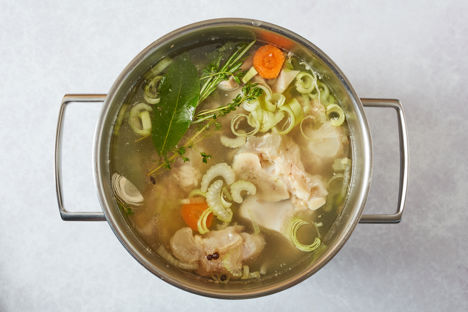White veal stock is one of the most under-appreciated but valued stocks in French cookery. It has a very delicate flavour, making it well-suited to veloutés or poaching white meat and can be used in place of a light chicken stock.
There are two types of veal stock; white and brown (which you can get the recipe for here). Whilst a brown veal stock sees the bones and vegetables roasted before being simmered in water, white veal stock sees the ingredients go in raw, which results in a lighter, more delicate flavour as well as a paler colour.
Professional kitchens have the capability to make tens of litres of veal stock at a time, which would usually be simmering away for no less than twelve hours. The recipe below has been adapted for the home kitchen, and therefore only takes four to six hours to create about two litres of top-quality stock.
As it takes a good few hours to prepare, it is a good idea to make up a large batch of stock and freeze in portions, so you always have some to hand. Read on for some tips on how to many the perfect white veal stock from scratch.
Veal still has a bad reputation for cruel farming practices, but actually in the UK these practices were outlawed in 1990, meaning the veal raised in Britain now is generally ethically raised – in particular rose veal, where the calves are fed a more varied diet. Having said that, it is always good to check with your butcher on the quality of the meat. Veal bones can be pretty tricky to get hold of (asking your butcher is usually the only way to get your hands on them), and they often come frozen and already chopped into smaller pieces (this needs to be done by your butcher anyway, as it requires a bandsaw). If your local butcher can’t help, there are some good quality British farmers and butchers selling veal bones online.
Knuckle bones or breast bones are best for making stock as they contain the most collagen, which will turn into gelatine when cooked, giving your stock body. Ensure they have been chopped into smaller pieces so maximum flavour can be extracted (and so they can fit in the pan).
Many of the old classical French recipes for veal stock call for veal meat as well as the bones, often shoulder or knuckle. This will obviously provide you with a very flavourful stock, but would cost a fair amount, which is why a lot of chefs today simply stick with the bones. A lot of chefs also add chicken bones in place of some of the veal bones, to make it more affordable and a little lighter in flavour.
The traditional vegetables used in a white veal stock are onion, leek (white part only), celery, garlic and sometimes carrot – though be careful with quantities as carrots can over-sweeten a stock. They can also discolour the liquid, so bear this in mind if you're after a particularly pale stock.
Bay, thyme, parsley stalks and rosemary sprigs are all commonly used to flavour white veal stock. Peppercorns (white or black) and sometimes a few cloves are used sparingly.
Always use cold, unsalted water when making a white veal stock. The process of cold water reaching boiling point encourages the fat and impurities to rise the the surface. You can then easily skim off the scum, resulting in a nice clear stock.
You should never salt a stock, as it reduces for so long it could easily end up too salty. Instead, season once it's reduced to your liking, or keep it unseasoned until you use it in a sauce.
The recipe below makes around 2 litres of stock, but feel free to scale up if you have a big enough stockpot.
Metric
Imperial
- 3kg veal bones, chopped into pieces
- 500g of ice
- 2 onions, finely sliced
- 1 leek, finely sliced
- 1 celery, finely sliced
- 1 carrot, finely sliced (optional)
- 1 garlic bulb, halved horizontally
- 1 bouquet garni
- 1 tsp black peppercorns
- 1 pig's trotter, split lengthways (optional) – this gives the stock extra body
While it may be prized in French professional kitchens as an essential, white veal stock isn't exactly an everyday ingredient home cooks come across in recipes. It is well worth getting to know it though – those in the know rave about the delicate umami flavour and body it adds to dishes. As a general rule of thumb, white veal stock can be used anywhere you might use a white chicken stock; the base of a soup or braise, a velouté, or even as a poaching liquor. Due to the high gelatine content in veal bones, a veal stock lends serious body to a gravy or sauce, meaning you don’t have to use a thickening agent such as a roux or cornflour. Due to its colour, white veal stock is often used as a base in white sauces, such as a cider or white wine cream sauce.
More often than not, a veal stock is reduced right down before using. This is for several reasons: as well as intensifying flavour and thickening it, from a practical stance, it is also a space saver – you can pour the reduced stock into ice cube trays and freeze. You can then pour boiling water over to defrost and rehydrate into a stock (just like a shop-bought stock cube, but with ten times the flavour). A stock reduced by half is known as a demi-glace and is used as a base for many classic sauces. Reduce the stock further (by ninety percent) and you will create a veal glace that's perfect for finishing dishes.
Get in touch
Please sign in or register to send a comment to Great British Chefs.


